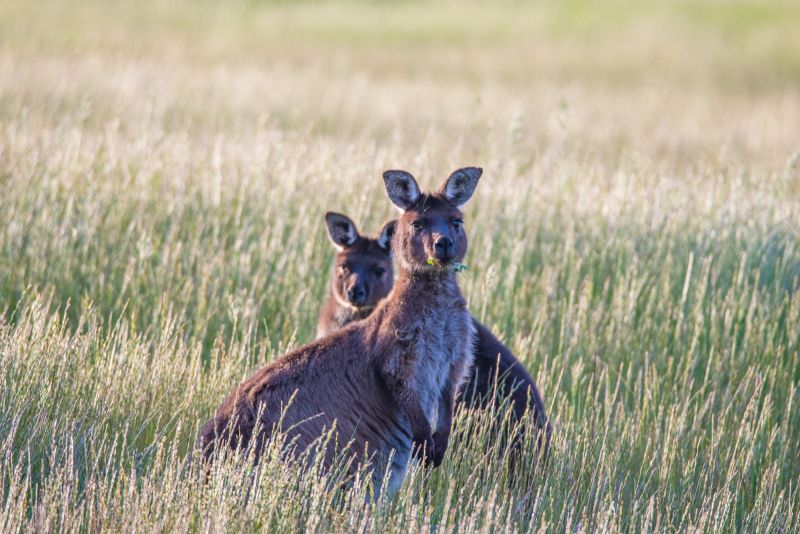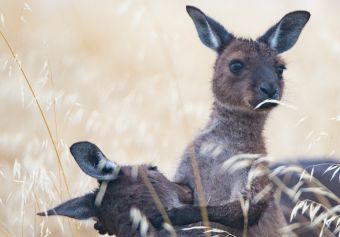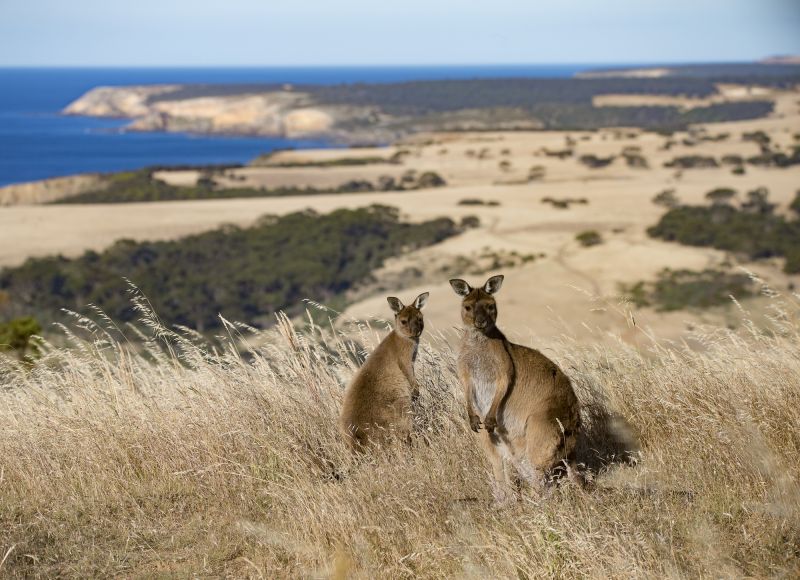The Kangaroo Island Kangaroo (Macropus fuliginosus fuliginosus) is a sub-species of the Western Grey Kangaroo (Macropus fuliginosus). As a result of a prolonged period of isolation from mainland Australia, the Kangaroo Island Kangaroo is noticeably different from other Western Grey species. Due to the Kangaroo Island landscape, this species have adapted to being shorter, stockier and a darker chocolate-brown colour. They characteristically have darker tips, such as ears, paws, feet and tails.

Both males and females become sexually mature at around 20 months old. The gestation period is 31 days and births occur throughout the year if conditions are good, with a peak in summer. Upon birth, the newborn joey climbs unaided through the female’s fur and into the pouch, where it attaches to one of four teats. Young stay in the pouch for 40-45 weeks, gradually spending more time out than in. If a mother loses a pouch young, she comes into oestrus (becomes fertile again) within 6 days and will then mate again.
Kangaroos move as a mob, with female young staying with their mother to help out with younger joeys as they come along. Dominant males have a strong scent gland on their chest, which they use to physically mark their territory. Within each mob, there is one male leader, or ‘the boss’, who visits each female and assesses their reproductive status by tasting their urine. If he finds one in oestrus, they mate. When other males come across this leader, they must submit by lowering their head - failure to do so indicates a challenge to fight - the winner becomes, or remains the leader.
Kangaroos are browsers and grazers. They often feed on open pasture, but can be found eating leaves of small bushes if other food sources are unavailable. They are most active in the late afternoon, throughout the night and into the early morning. During the days, they are usually found resting in the shade, particularly during hot weather. In the colder months, they will be found grazing in open pasture adjacent to woodland.
 Where can I see this species with an expert guide?
Where can I see this species with an expert guide?
Kangaroo Island In Style Tour (2D/1N)
This tour combines the two most popular full day landscape and wildlife experiences; Island Life and Flinders Chase Focus. Guests will be exposed to a broad range of elements including the Island's history, ecology, wildlife, landscape and contemporary lifestyle. Iconic landscapes in the southwest corner will deliver endless photographic opportunities especially at Remarkable Rocks, Admirals Arch and Cape du Couedic.
Key species regularly encountered are Koalas, Tammar Wallabies, Kangaroo Island Kangaroos, endangered Glossy Black Cockatoos, Short-beaked Echidnas, Australian Sea-lions, Long-nosed Fur-seals and a variety of bush birds and shorebirds and seabirds.
Find Out More
Kangaroos often get around using all four limbs plus their tail. Taking their weight on their small front paws and tail, they swing their large hind feet forward and repeat the process. A more recognisable method of travel is, of course, hopping, which actually makes it a more efficient mode of travel the faster they go - up to a point. The energy is stored in their thick achilles tendon while the hopping motion and movement of the internal organs assists in making breathing effortless. The rising mass causes air to be expelled from the lungs and, as their viscera falls, it draws air in.

FAQs
Q: Is it true that Kangaroos cannot move backwards?
A: Not completely - the structure of their legs makes it very difficult to move backwards, however they can do this is in an awkward shuffle pushing back with their forearms.
Q: How many Kangaroo Island Kangaroos live on Kangaroo Island?
A: It is believed that numbers are in excess of 65,000 individuals.
Q: Do Kangaroos actually ‘box’?
A: Yes! They also use their paws to grab onto the other Kangaroo’s chest, lean back on their tail and then kick with their hind legs.
Q: Who named Kangaroo Island?
A: In 1802, British explorer Captain Matthew Flinders discovered the island whilst mapping the southern coast of Australia. As he and his crew landed, they came across a large number of Kangaroos which Flinders likened to the Kangaroos on the east coast of Australia. These Kangaroos were shot and eaten by the crew, who were beginning to grow increasingly hungry as a result of the small food rations on the ship. In his journal, Flinders wrote "in gratitude for so seasonable a supply I named this southern land Kanguroo (sic) Island.”


